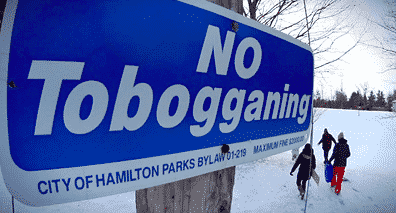
Canadian winters have a very interesting dual effect: they simultaneously push people indoors and outdoors. For some, they wish to avoid the bitter cold. For others, they wholeheartedly welcome the changing weather’s invitation to get involved in winter sports.
As with most outdoor activities, there is inherent risk of serious injury with winter sports, such as tobogganing. Despite this risk, Ontario’s Courts have found that there are circumstances where municipalities are partially or solely liable for tobogganing accidents.
 In 2013, the landmark case of Uggenti v. City of Hamilton sent shockwaves through Ontario’s municipal government offices. Prior to being appealed to the Superior Court, an Arbitrator, the Honourable Justice Eugene Fedak, a retired Superior Court Justice, found that the City of Hamilton was solely responsible for Mr. Uggenti’s tobogganing accident.
In 2013, the landmark case of Uggenti v. City of Hamilton sent shockwaves through Ontario’s municipal government offices. Prior to being appealed to the Superior Court, an Arbitrator, the Honourable Justice Eugene Fedak, a retired Superior Court Justice, found that the City of Hamilton was solely responsible for Mr. Uggenti’s tobogganing accident.
Mr. Uggenti was seriously injured when he and his spouse were thrown from their sled after striking the edge of a snow-covered ditch on their first run down a slope. The hill was located on reservoir property owned by the City. Before descending the slope, Mr. Uggenti watched his children toboggan down the slope on two occasions without incident. Prior to his run, he also noticed a slight depression across the bottom of the slope. He was not aware of the City’s By-Law prohibiting tobogganing.
The Superior Court held upheld the Arbitrator’s finding that the City had breached the duty of care outlined in section 3 of the Occupiers’ Liability Act. Under subsection 3(1) of this statute, an occupier of premises owes a duty to take such care as is reasonable in all the circumstances to see that persons entering on the premises are reasonably safe while on the premises. Subsection 4(1) states the duty outlined in s. 3(1) does not apply with respect to risks willingly assumed by a person who enters on the premises; as in that case, the occupier owes a duty “to not create a danger with the deliberate intent of doing harm or damage to the person…and to not act with reckless disregard of the presence of the person…”.
With inherently dangerous activities, such as winter sports, there is always the argument that the participant is willingly assuming the activity’s inherent risk of injury. However, for someone to be deemed as willingly assuming the risk, the individual must be aware of the existence of the distinct risk itself. Specifically, this willing assumption of risk is predicated not only on knowledge of the risk, but also consent to the legal risk, or in other words, a waiver of legal rights that may arise from the harm or loss that is being risked.
The City contended that Mr. Uggenti was aware of the general risk involved in tobogganing as he had a prior tobogganing mishap and should have been aware of the particular danger associated to the slope as he saw a depression in the topography prior to his run. Mr. Uggenti was found to not be aware of the risk he was assuming as he was unaware of the ditch that was near the bottom of the slope, which effectively posed as a hidden danger. The fact that Mr. Uggenti did not know that there was a City By-Law prohibiting tobogganing was also weighed into consideration in this analysis, but did not overshadow the other factors. Effectively, this decision indicated that cities and municipalities cannot fully shield themselves from a finding of liability by simply imposing a prohibitory by-law.
The Court proceeded to determine whether Mr. Uggenti played any role in his misfortune by examining whether he was contributorily negligent. In Bow Valley Husky (Bermuda) Ltd. v. Saint John Shipbuilding Ltd., the Supreme Court of Canada adopted the following test for contributory negligence:
A person is guilty of contributory negligence if he ought reasonably to have foreseen that, if he did not act as a reasonable, prudent man, he might hurt himself; and in his reckonings he must take into account the possibility of others being careless.
The City argued that the reasonable, prudent person would have foreseen that the depression that was observed prior to launching may have caused an injury while tobogganing and that tobogganing itself might cause injury. Ultimately, no contributory negligence was found against Mr. Uggenti or his spouse.
Unsurprisingly, since Uggenti, other municipalities, such as Orangeville, have engaged in city-wide prohibition of tobogganing in order to prevent any exposure to further personal injury lawsuits. Other cities, such as Ottawa and Toronto, have increasingly prohibited tobogganing on certain hills. In December 2016, after years of protest and petitions, the City of Hamilton re-opened and permitted tobogganing on four designated hills.
Shortly after Uggenti, the case of De Cou v. The Municipality of Leamington was heard before the Honourable Justice Thomas J. Carey. The case of Uggenti was not considered by Justice Carey. In this case, it was determined that Ms. De Cou simply lost control of her toboggan and did not strike a log or any other hidden obstruction as she had alleged. In stark juxtaposition to Uggenti, Ms. De Cou was found to have willing assumed the known risk that she could be injured. In his decision, Justice Carey stated that:
Going down a snow covered hill in February on a light piece of material…is a typical Canadian winter experience. Falling off a sled is also part of that experience.
No causal connection was found between the Municipality’s failure to supervise or inspect the hill and Ms. De Cou’s injuries.
Given the contrasting decisions in Uggenti and De Cou, there are still unresolved questions, but it can be definitively concluded that there are very specific circumstances and facts which drove both these cases and their findings. An experienced personal injury lawyer can assist in this regard.
In the event of a tobogganing or any winter sport accident, it is best to consult with a lawyer in a timely matter to discuss whether there is the potential of seeking recourse against any negligent parties, including the Municipality or City.
For additional reading, visit: Tips For Safe Tobogganing.
For more information, please contact Michael J. Henry at 416-361-0889 or mjhenry@hshlawyers.com.





